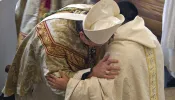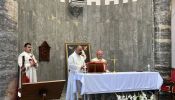Every year at our Vigil of All Saints, we meet people who say: “This is great! Why don’t we do this everywhere?” In fact, every year, we get inquiries from around the country asking us to help them get their own local Vigil of All Saints up and running. We have collected here most of the resources that a typical parish, campus ministry, religious house, seminary, or other group would need to put on their own Vigil of All Saints.
The Vigil of All Saints has become among the most popular events here at the Dominican House of Studies. “Inspiring” and “beautiful” does not capture the experience of the people who attend: somehow, the Vigil gives us a taste of great riches of the Catholic tradition - a taste for which most Catholics today hunger. It also makes us aware of the connection - powerful and real - to the long line of saints who have lived before us, and who still love us and help us with their prayers.
Amidst the secular celebrations of Halloween, the Vigil of All Saints is a marvelous opportunity to reclaim, re-Christianize, and evangelize a night that is almost universally celebrated without any reference to Christ. Here is fertile soil to sow the seeds of what John Paul II called “The New Evangelization.”
Overview of the Vigil
The Vigil is based on the monastic office of Vigils (or Matins), when the monks would arise in the middle of the night to pray. On major feast days, they would have an extended service of readings (scriptural, patristic, and from lives of the saints) in addition to chanting the psalms. This all would be done in the dark, of course, and was an opportunity to listen carefully to the Word of God as well as the words of the Church Fathers and great saints. The Vigil of All Saints is an adaptation of this ancient practice, using the canonical office of Compline at the end.
Structure of the Liturgy
Part One - Readings & Sermon
Entrance Procesion (with organ accompaniment)
O Sacrum Convivium (”O Sacred Banquet”) - opening prayer said before all canonical offices in the Dominican order when in the presence of the Blessed Sacrament.
Hymn
Opening Prayer - by the presiding priest or deacon.
Four Readings from lives of the Saints - The readings are done by four different lectors. Each reading is followed by a brief sung versicle and response (cantors, then congregation) or, alternatively, an antiphon (cantors, then congregation).
Te Deum - the ancient hymn of praise chanted at Vigils on Feasts, Solemnities, and Sundays. We chant it according to the old Dominican chant, in Latin. (Of course, there is also a well-known Gregorian chant version.)
Scripture Reading & Sermon - the preacher preaches on themes related to the feast: friendship with the saints, the communion of saints, the meaning of devotion to the saints, etc.
Part Two - Compline & Procession
Opening Invocation to Begin Compline - “O God, come to my assistance,” etc.
Examination of Conscience and Confiteor
Chanting of the Psalms of Compline - by the whole congregation, led by a cantor and sub-cantor, sung side-to-side in monastic fashion.
Short Reading from Compline - Deut. 6:4-7.
Responsory - “Into your hands, Lord…” sung by two cantors, with congregation responding.
Nunc Dimittis (Canticle of Simeon) - Sung by the whole congregation in the same fashion as the psalms. At this point, servers light the candles of all in the congregation, in preparation for the procession.
Concluding Prayer - by the presiding priest or deacon.
Salve Regina - intoned by cantor, sung by all.
Procession - to the Reliquary (or to decorated altar/sacred images to be venerated). The whole congregation walks in the procession, holding lit candles, led by cross and candles and followed by the presiding priest or deacon. The Litany of the Saints is sung during the procession. (This is the often the favorite part of the Liturgy.)
Veneration of Relics - The presiding priest or deacon first incenses the reliquary, and then all those in the procession. (The Litany is sung throughout.)
Concluding Blessing and Dismissal
Resources for Your Vigil
Readings from the Lives of the Saints - the various readings we’ve used in our Vigil over the past five years.
Presider’s Prayers and Texts - Everything that the presiding priest or deacon needs in his binder in order to lead the service.
Litany of the Saints - An expanded version of the Litany of the Saints (long enough to cover the whole procession and veneration), set to the Dominican chant tone (different than the typical Roman version).
All Saints Vigil Program 2006 - A .pdf version of our complete program for the 2006 Vigil of All Saints, including the opening hymn, and the complete order of Compline: opening invocation, antiphons, psalms, responsory, and Nunc Dimittis (all with their proper music).
Rubrics and Practical Tips for a Successful All Saints Vigil
A prayerful liturgy depends on good execution by the ministers and ushers, and that depends on good planning. Planning well, keeping in mind the layout of your church or chapel, will be key to providing a liturgy that is free from distractions for the congregation. These rubrics and planning tips will help.
The Planning: We begin planning about 6 weeks in advance, leaving plenty of time to choose readings, prepare publicity, and get invitations out. It is a great witness to have lots of religious gathered for this event, and that is always something people comment on. Send invitations to all of the religious houses in your area, as well as to the local seminary, and to local clergy. You might also invite all of the young adult groups/youth groups in the area. We have brothers in charge of making the program, cantors in charge of the music: rehearsing, compiling the litany (we ask people to submit the names of their favorite saints to include in the litany), gathering the music, a brother in charge of invitations and publicity, and a food committee (to bake and cook for the reception afterwards).
Pick out your readers with care — a long reading in the dark calls for a good reader who is easily understood and can effectively convey the meaning of the text. This first half of this liturgy is a very aural experience, so it needs readers (and readings) that can hold the listener’s attention without any other stimuli.
The Rehearsal: Make sure that every major player in the liturgy can attend. Readers should practice with the sound system. Figure out where each person is going to sit. Reserve seats in the sanctuary for clergy, and in the front section for religious, and make sure all the ushers know where those reserved sections are. Cantors and readers should practice moving from their seats to the ambo or lectern where they will be reading/singing, and they should be educated on how to make the proper reverence to the altar as they pass it.
The most important thing to rehearse in detail is the procession. Figure out the route of the procession and assign each usher a specific task for getting different sections out of their seats and moving in the procession, standing in their places at the end of the procession, etc.
The Setup: The church or chapel should not be fully lit. We have only about 1/3 of the lights on at the beginning. Use as many candles as you can — part of the appeal of this liturgy is that it feels ”haunting,” in a good sense of the word, and real candlelight helps that feeling. Perhaps place extra candles on the altar, in front of the ambo, or elsewhere in the sanctuary.
As everyone comes in, they should get a program (with the psalms of Compline, the hymn, etc.) and a candle (as at the Easter Vigil).
The Entrance Procession: Servers (properly vested, of course) lead the procession, carrying cross and candles. (Incense could also be used, the thurifer walking ahead of the crucifer.) The presiding priest or deacon follows, vested in alb, stole, and white cope. We do not sing a hymn at this point, but rather have the organist play an organ instrumental, lasting just long enough for the procession to reach the sanctuary and for the ministers to get to their places.
O Sacrum: All kneel for this prayer, led by the presiding priest or deacon, who is kneeling on the sanctuary steps (or the steps of the altar). Servers should immediately go to their places and set down their candles and cross before the O Sacrum is begun, giving them time to kneel as well.
Hymn: Play loudly, sing louder!
Opening Prayer: Said by the presider from the chair.
At the conclusion of the prayer, all the lights are turned off. The only light remaining (aside from the candles) is the light illuminating the text for the reader. All are seated.
The readings from lives of the Saints: This is a key component of the Vigil. Picking good readings is important. They should be about 3-5 minutes long. We change the saints that we read from every year, in order to emphasize the great richness of the saints in heaven. We also try to pick saints that people probably don’t know a lot about, or haven’t already read. We have found that, in general, narrative accounts are better than a homily or a spiritual treatise. People can easily follow the account of a martyrdom, but not always a mystical vision. We also try to vary the category of saints: a martyr, a virgin, someone from the early Church, someone more recent, a layman or laywoman, a mother, etc.
Te Deum: Our schola sings the Dominican Te Deum in Latin. It is important, we think, to sing at least some of this liturgy in Latin — people love the idea that they’re going to hear real Gregorian chant, and its in a context where they can really feel like it’s prayerful for them (and in the dark).
Scripture Reading and Sermon: The preacher chooses the reading, which he reads, and then preaches. We turn on one light that illuminates his face, but that’s it. Otherwise, everyone sits in the dark.
After the sermon, a brief period of silence follows. Then a cue is given for the lights to come on (not all the lights in the church or chapel, but just enough to permit the congregation to read their programs for Compline.)
Compline Begins: The presiding priest/deacon begins the invocation “O God, come to my assistance,” and all respond, as indicated in the program. We accompany this with the organ.
Examination of Conscience and Confiteor: All then kneel for a period of silence. The presider needs to tell people “We will now kneel in silence for an examination of conscience.” He then begins (and everyone joins) in saying the “I Confess. . . .” At the conclusion, all sit.
Psalms of Compline: The lead cantor, who should be sitting on one side of the chapel/church, stands up and sings the antiphon of the first psalm, as well as the first line of the psalm. We accompany this with the organ. It is probably best that the cantor not sing from the ambo, but from a seat with the congregation, since he is just leading that side of the congregation (and needs to be identified with it). The cantor’s side of the church joins in singing the second line of the psalm, and then the other side of the church sings the next two lines. The two sides alternate, each singing two lines back and forth. The subcantor should be sitting on the opposite side of the congregation from the lead cantor, and he should help the other side join in the singing of the second two lines of the psalm. After the first psalm is finished, the antiphon is repeated. Then the subcantor stands up and intones the second antiphon, and the first line of the second psalm, etc.
The Compline Reading: The short reading from Compline can be done from the ambo or from the congregation (if someone has a loud enough voice).
The Responsory: Also accompanied by the organ. All stand. The two cantors come together and sing standing side-by-side, with the congregation responding. Could be done from the ambo, but perhaps works better with them standing in the aisle of the congregation, facing the altar. (If they sing strongly enough, no microphone is necessary — people will be listening.) NB: They should bow in reverence to the altar when they move to stand in front of it.
During the responsory, the servers get their candles.
The Nunc Dimittis: The cantors do not return to their seats but, still standing before the altar, the lead cantor sings the antiphon for the Nunc Dimittis, and then the first line (accompanied by the organ). The rest of the congregation then joins in. As soon as the congregation begins singing, the servers carrying candles leave the sanctuary and begin lighting the candles of all those in the congregation, returning in time for the conclusion of the nunc dimittis. (When the antiphon is sung a second time, they should be moving back to the sanctuary.)
Concluding Prayer: Said from the chair.
Salve Regina: Intoned (without organ) by the cantor, with the congregation joining in. We sing the Roman Salve in Latin (because most people know it). It is a marvelous feeling of unity to sing all together without the organ.
The Procession: After the Salve, the cantors begin the Litany. At the same time, the cross and candles leave the sanctuary and the procession begins. We walk down the main aisle of the chapel and into our cloister walkway, where our reliquary is found. (The procession could go to a special altar, decorated for the occasion, or to a place where some icons or other sacred images have been prepared and decorated.) Ushers direct the clergy from the sanctuary, the religious, and then the rest of the congregation to follow the cross and candles. The presider comes last.
When the cross and candles reach the reliquary or shrine, they take up positions flanking it. Those following in the procession line up around the reliquary/shrine. When the presider arrives, he incenses the relics/shrine (a thurible has either been prepared by the reliquary, or is carried in procession by a server), and then walks through the congregation, who are standing in a double-file line, incensing them. Meanwhile, the litany continues until all the incensing is finished. (Arrange a signal ahead of time for an usher to give to the cantors so that they will know when to begin wrapping up the litany. The timing of procession will depend on how many people are present and how quickly they move, so it is good to have a cushion of extra saints’ names in the litany that can cover the whole procession if it takes longer than expected.) Finally, the litany having been concluded, the presider says the concluding blessing.
The Reception: Since this is a festive occasion (and most people are choosing to come to this instead of a Halloween party), it’s important to celebrate afterwards. We have a reception already set up, with lots of punch, desserts, and other treats made by the brothers. It’s a great time to celebrate!
We have a team of confessors hearing confessions before and after the Vigil. That has proven to be a valuable part of the overall program — this year, we still had lines for confession even an hour after the Vigil ended.
If you have any other questions, please feel free to contact us at dominicanstudents@dhs.edu. We’d love to hear from anyone who is planning a Vigil - please let us know how it goes!
This article was published with permission from The Dominican Friars in Washington, D.C.











